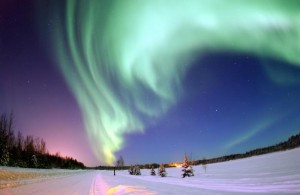Auroras are something I have always heard about, but I have never been sure of what they are exactly. We have all seen the pictures of the beautiful green, red, and blue lights in the sky, but I would bet that few of us have ever seen one in person. The National Oceanic and Atmospheric Administration website says that there is almost always at least a small aurora somewhere in the sky, but they are generally difficult to see. This is because they are most common in the far northern and southern latitudes. In the north, the best locations tend to be Canada, Alaska, Northern Greenland, Scandinavia, and Siberia for seeing auroras. Also, the best time to see an aurora is in the middle of winter between 10:00 p.m. and 2:00 a.m.
The northern and southern versions of auroras were first named in 1621 by a French Scientist named Pierre Cassendi. The northern lights, or Aurora Borealis, were named after the Roman goddess of dawn (Aurora) and the Roman god of the north wind (Boreas). The southern auroras are named Aurora Australis for “southern dawn.”
The formation of Auroras begins on the Sun 93 million miles away and ends 60 to 600 miles above Earth’s surface. The Sun sometimes emits highly charged protons and electrons. This solar wind then energizes protons and electrons within Earth’s magnetic field, which travel down magnetic field lines to Earth’s atmosphere near the poles. These charged particles then excite atmospheric gas atoms and molecules. As they relax back down to their normal state, the molecules and atoms release the energy as visible light, which we see as auroras.
The National Oceanic and Atmospheric Administration (NOAA) keeps track of these solar storms that can lead to auroras. Strong storms can cause trouble with satellites, power grids, GPS signals, communication technology, and even astronaut safety. Luckily for us, it also means that they monitor where and when auroras occur on Earth. You can visit the Space Weather Prediction Center’s Aurora website to see the current auroras. If you happen to be far north and there is a strong storm, maybe you’ll get a chance to see one. I hope I do someday!



First one to post, so I thought I’d give you a free comment. This is a nice entry including some personal text and good description of the physical phenomenon. The pictures are great in your post too. I think the aurora maps from the NOAA POES satellite are very interesting; you have to dig around just a bit to find them. Curious that NOAA rather than NASA is the relevant agency for aurora observation, but I suppose they are related to weather, broadly defined. I like the Michigan Tech (http://www.geo.mtu.edu/weather/aurora/) and Univ Alaska (http://www.gi.alaska.edu/AuroraForecast) sites too.
By the way, I think you’re right that only one of your classmates has ever seen an aurora… Mackenzie?
When I was vacationing with my family in a rather remote area of Canada about four hours north of the of northern-most tip of New York we would love to canoe out in the middle of the lake our cabin was on in the middle of the night. Up there the darkness is so unfathomable that you couldn’t even see you hand in front of your face without a flashlight.
One night the whole sky was lit up and it wasn’t even necessary to bring a flashlight. Turns out, the aurora borealis was putting on quite the show for us. Definitely one of the most beautiful, and natural shows I have ever witnessed. Make the effort to get outside at night if you are ever far enough north!